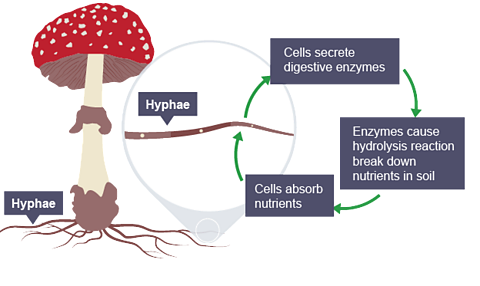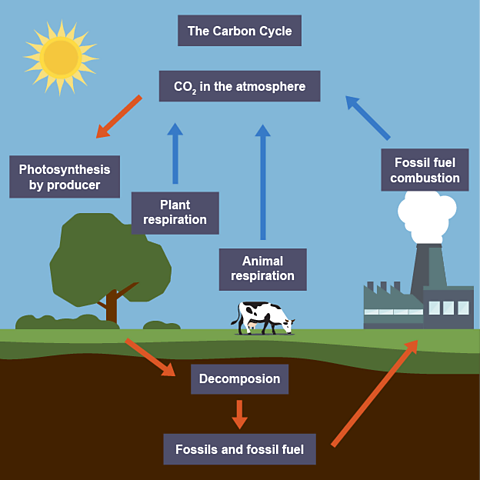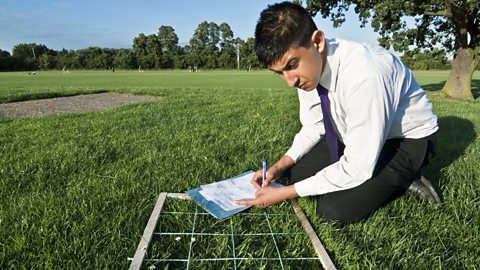What is decomposition?
Decomposition is the process where bacteria and saprophyticRefers to organisms, like fungi and bacteria, that obtain their nutrients from dead and decaying organic matter. fungi break down dead organisms into simple compoundsA substance formed by the chemical union of two or more elements..

Steps
Bacteria/fungi secretTo release a substance, in this case an enzyme. enzymesProteins that act as biological catalysts, meaning they speed up reactions without being used up themselves.out onto the dead organisms.
Enzymes digest the organic matter outside their cells. This is known as extracellular digestion as it happens outside the cells.
The products of digestion are absorbed by the bacteria and fungi.
This process returns nutrients like carbon and nitrogen to the soil, air, and water (abiotic componentsThe non-living, physical, and chemical parts of an environment that impact living organisms and ecosystem functioning.) so plants can use them. Plants then support animals (biotic componentsAll the living organisms, including plants, animals, fungi, and microorganisms, within an ecosystem, as well as their waste and dead remains.). The remaining material forms humusThe dark, rich, organic matter in soil formed from the decomposition of plant and animal matter. in soil, which improves soil fertility.
How do you investigate the key features of the decay process?
Procedure
- Place bread samples in aerobic (with oxygen) and anaerobic (without oxygen) setups.
- Spray half the samples with water; leave the rest dry.
- Store at -18°C (freezer), 4°C (fridge), and 20°C (room) for two weeks.
- Observe and record signs of decay.
Results
Key: ✓ = signs of decay x = no signs of decay
| Conditions | water / oxygen | no water / oxygen | water / no oxygen | no water / no oxygen |
|---|---|---|---|---|
| -18°C | x | x | x | x |
| 4°C | x | x | x | x |
| 20°C | ✓ | x | x | x |
Only 20°C is a suitable temperature, as the other two temperatures are too cold and the other columns have one or more key condition needed for decay to be absent.
Conclusion
Decomposition occurs quickly when:
- the temperature is warm
- water is present
- oxygen is available
Nutrient cycles
In ecosystemA community of animals, plants and microorganisms, together with the habitat where they live., plants absorb inorganicNot derived from living matter. nutrients like carbon dioxide (from the carbon cycle) and nitrates, (from the nitrogen cycle) to build complex molecules.
These molecules pass through food chains and, when organisms die, decomposers break them down, returning carbon and nitrogen to the atmosphere and soil for reuse.
How does the carbon cycle work?
A balanced carbon cycle is essential.
Carbon is a major component in carbohydrates, fats and proteins.
The carbon cycle involves the exchange of carbon between living organisms (biotic) and their atmosphere (abiotic).
In the carbon cycle, carbon is constantly removed from, and returned to, the environment keeping it in balance.

Processes involved in the carbon cycle are:
Photosynthesis
Plants absorb carbon dioxide from the atmosphere use it to form sugars and starch. This is the only process that reduces carbon dioxide levels in the air.
Feeding
Carbon in biological molecules moves through the food chain as animals eat plants and other animals.
Respiration
All living organisms (plants, animals, and decomposers) release carbon dioxide into the atmosphere when they respire. This is a form of excretionProcess by which waste products from chemical reactions in an organism are removed..
Fossilisation
If conditions are not favourable for the process of decomposition, dead organisms decay slowly or not at all. These organisms build up and, if compressed over millions of years, can form fossil fuels (coal, oil or gas).
Combustion
Burning fossil fuels releases stored carbon back into the atmosphere as carbon dioxide.
Excretion
Waste materials (eg urine) are released by organisms. Decomposers break these down, releasing carbon dioxide to the air.
Egestion
Animals remove undigested food as faeces, which contain carbon. Decomposers break faeces down, releasing carbon dioxide into the air.
Decomposition
Bacteria and saprophytic fungi break down complex carbon compounds in dead organisms, faeces and urine into simpler carbon compounds, returning them to the atmosphere or soil.
Test your knowledge
More on Biodiversity
Find out more by working through a topic
- count1 of 5

- count2 of 5
